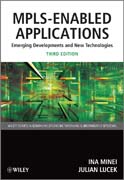
MPLS-enabled applications: emerging developments and new technologies
Minei, Ina
Lucek, Julian
INDICE: About the Authors. Foreword. Preface. Acknowledgements. Part One. 1Foundations. 1.1 Historical perspective. 1.2 Current trends. 1.3 MPLS mechanisms. 1.4 Conclusion. 1.5 References. 1.6 Further reading. 1.7 Study questions.2 Traffic Engineering with MPLS (MPLS-TE). 2.1 Introduction. 2.2 The businessdrivers. 2.3 Application scenarios. 2.4 Setting up traffic-engineered paths using MPLS-TE. 2.5 Using the traffic-engineered paths. 2.6 Deployment considerations. 2.7 Using traffic engineering to achieve resource optimization. 2.8 Offline path computation. 2.9 Conclusion. 2.10 References. 2.11 Further reading. 2.12 Study questions. 3 Protection and Restoration in MPLS Networks. 3.1 Introduction. 3.2 The business drivers. 3.3 Failure detection. 3.4 End-to-end protection. 3.5 Local protection using fast reroute. 3.6 Link protection. 3.7 Node protection. 3.8 Additional constraints for the computation of the protection path. 3.9 Interaction of end-to-end protection and fast reroute. 3.10 Deployment considerations for local protection mechanisms. 3.11 IP and LDP FRR. 3.12 Conclusion. 3.13 References. 3.14 Further reading. 3.15 Study questions. 4 MPLS DiffServ-TE. 4.1 Introduction. 4.2 The business drivers. 4.3 Application scenarios. 4.4 The DiffServ-TE solution. 4.5 Extending the DiffServ-TE solution with multiclass LSPs. 4.6 Conclusion. 4.7 References. 4.8 Further reading. 4.9 Study questions. 5 Interdomain Traffic Engineering. 5.1 Introduction. 5.2 The business drivers. 5.3 Setting up interdomain TE LSPs. 5.4 Interprovider challenges. 5.5 Comparison of the LSP setup methods. 5.6 Conclusion. 5.7 References. 5.8 Further reading. 5.9 Study questions. 6 MPLS Multicast. 6.1 Introduction. 6.2 The business drivers. 6.3 P2MP LSP mechanisms. 6.4 LAN procedures for P2MP LSPs. 6.5 Coupling traffic into a P2MP LSP. 6.6 MPLS fast reroute. 6.7 Ingressredundancy for P2MP LSPs. 6.8 P2MP LSP hierarchy. 6.9 Applications of point-to-multipoint LSPs. 6.10 Conclusion. 6.11 References. 6.12 Study questions. Part Two. 7 Foundations of Layer 3 BGP/MPLS Virtual Private Networks. 7.1 Introduction. 7.2 The business drivers. 7.3 The overlay VPN model. 7.4 The peer VPN model. 7.5 Building the BGP/MPLS VPN solution. 7.6 Benefits of the BGP/MPLS VPNsolution. 7.7 References. 7.8 Further reading. 7.9 Study questions. 8 Advanced Topics in Layer 3 BGP/MPLS Virtual. Private Networks. 8.1 Introduction. 8.2 Routing between CE and PE. 8.3 Differentiated VPN treatment in the core. 8.4 Route reflectors and VPNs. 8.5 Scalability discussion. 8.6 Convergence times ina VPN network. 8.7 Security issues. 8.8 QoS in a VPN scenario. 8.9 IPv6 VPNs.8.10 Conclusion. 8.11 References. 8.12 Further reading. 8.13 Study questions.9 Hierarchical and Inter-AS VPNs. 9.1 Introduction. 9.2 Carriers carrier
- ISBN: 978-0-470-66545-9
- Editorial: John Wiley & Sons
- Encuadernacion: Rústica
- Páginas: 632
- Fecha Publicación: 07/01/2011
- Nº Volúmenes: 1
- Idioma: Inglés
